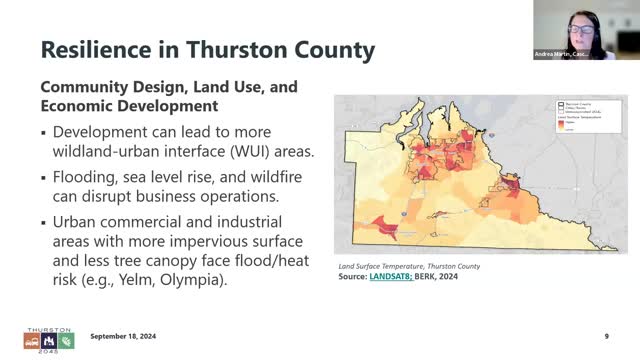Thurston County faces urgent climate crisis and emission challenges
September 18, 2024 | Thurston County, Washington
This article was created by AI summarizing key points discussed. AI makes mistakes, so for full details and context, please refer to the video of the full meeting. Please report any errors so we can fix them. Report an error »

During a recent government meeting, officials discussed the pressing impacts of climate change on Thurston County, highlighting significant risks to natural resources, agriculture, and community health. The meeting underscored the urgency of addressing rising land surface temperatures, particularly in areas like Yelm and Olympia, which are identified as higher risk zones.
The discussion revealed that climate change poses threats to croplands, with potential impacts on crop quality, pest prevalence, and livestock health due to heat stress and flooding. Additionally, the county's marine ecosystems face challenges from ocean warming and acidification, while forest growth is hindered by drought and invasive species.
A key focus was on greenhouse gas emissions, with the county's 2022 emissions estimated at 14.1 metric tons of carbon dioxide equivalent per capita, slightly above the statewide average of 13.5. The primary sources of these emissions include transportation, electricity consumption, and tree loss. Notably, over half of the emissions from the transportation sector stem from passenger vehicle travel.
Officials also addressed the county's operational emissions, which totaled nearly 12,000 metric tons, representing less than 1% of community-wide emissions. The meeting emphasized the need for alignment with state greenhouse gas reduction targets, which call for a 45% reduction by 2030, 70% by 2040, and 95% by 2050, based on 2015 levels.
Concerns were raised regarding the impact of commercial forestry operations on emissions calculations, as many of these activities fall outside the county's jurisdiction. Officials acknowledged the complexity of accounting for emissions from land use changes, particularly tree loss, which has affected approximately 20,000 acres since 2016.
The meeting concluded with discussions on potential strategies for incentivizing sustainable forest management practices and enhancing carbon sequestration efforts, highlighting the importance of collaboration with agricultural operators and state agencies to achieve climate goals.
The discussion revealed that climate change poses threats to croplands, with potential impacts on crop quality, pest prevalence, and livestock health due to heat stress and flooding. Additionally, the county's marine ecosystems face challenges from ocean warming and acidification, while forest growth is hindered by drought and invasive species.
A key focus was on greenhouse gas emissions, with the county's 2022 emissions estimated at 14.1 metric tons of carbon dioxide equivalent per capita, slightly above the statewide average of 13.5. The primary sources of these emissions include transportation, electricity consumption, and tree loss. Notably, over half of the emissions from the transportation sector stem from passenger vehicle travel.
Officials also addressed the county's operational emissions, which totaled nearly 12,000 metric tons, representing less than 1% of community-wide emissions. The meeting emphasized the need for alignment with state greenhouse gas reduction targets, which call for a 45% reduction by 2030, 70% by 2040, and 95% by 2050, based on 2015 levels.
Concerns were raised regarding the impact of commercial forestry operations on emissions calculations, as many of these activities fall outside the county's jurisdiction. Officials acknowledged the complexity of accounting for emissions from land use changes, particularly tree loss, which has affected approximately 20,000 acres since 2016.
The meeting concluded with discussions on potential strategies for incentivizing sustainable forest management practices and enhancing carbon sequestration efforts, highlighting the importance of collaboration with agricultural operators and state agencies to achieve climate goals.
View full meeting
This article is based on a recent meeting—watch the full video and explore the complete transcript for deeper insights into the discussion.
View full meeting
